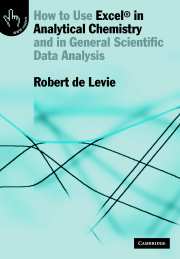Crossref Citations
This Book has been
cited by the following publications. This list is generated based on data provided by Crossref.
Carpenter, C.E.
2003.
Validation of Analytical Measurements by Single‐trial and Collaborative Study.
Journal of Food Science Education,
Vol. 2,
Issue. 1,
p.
7.
Sayago, Ana
and
Asuero, Agustin G.
2004.
Fitting Straight Lines with Replicated Observations by Linear Regression: Part II. Testing for Homogeneity of Variances.
Critical Reviews in Analytical Chemistry,
Vol. 34,
Issue. 3-4,
p.
133.
Pai, Su-Cheng
2004.
Temporally convoluted Gaussian equations for chromatographic peaks.
Journal of Chromatography A,
Vol. 1028,
Issue. 1,
p.
89.
Neuhold, Yorck-Michael
and
Maeder, Marcel
2006.
Practical Guide To Chemometrics, Second Edition.
p.
217.
Asuero, Agustin G.
2007.
Buffer Capacity of a Polyprotic Acid: First Derivative of the Buffer Capacity andpKaValues of Single and Overlapping Equilibria.
Critical Reviews in Analytical Chemistry,
Vol. 37,
Issue. 4,
p.
269.
Belkova, N. V.
Epstein, L. M.
Krylova, A. I.
Faerstein, E. G.
and
Shubina, E. S.
2007.
Kinetics of protonation of tungsten hydrides WH(CO)2(NO)L2 by weak OH-acids.
Russian Chemical Bulletin,
Vol. 56,
Issue. 5,
p.
870.
Asuero, Agustin G.
and
González, Gustavo
2007.
Fitting Straight Lines with Replicated Observations by Linear Regression. III. Weighting Data.
Critical Reviews in Analytical Chemistry,
Vol. 37,
Issue. 3,
p.
143.
González López, Rubén Alberto
2008.
Evaluación de algoritmos para estimar la derivada de presión en pruebas de pozos.
Ingeniería y Región,
Vol. 5,
Issue. ,
p.
91.
Michałowski, Tadeusz
2010.
The Generalized Approach to Electrolytic Systems: I. Physicochemical and Analytical Implications.
Critical Reviews in Analytical Chemistry,
Vol. 40,
Issue. 1,
p.
2.
Asuero, Agustin G.
and
Michałowski, Tadeusz
2011.
Comprehensive Formulation of Titration Curves for Complex Acid-Base Systems and Its Analytical Implications.
Critical Reviews in Analytical Chemistry,
Vol. 41,
Issue. 2,
p.
151.
Asuero, Agustin G.
and
Bueno, Julia Martin
2011.
Fitting Straight Lines with Replicated Observations by Linear Regression. IV. Transforming Data.
Critical Reviews in Analytical Chemistry,
Vol. 41,
Issue. 1,
p.
36.
Rocha-Martín, Javier
Vega, Daniel
Bolivar, Juan M
Godoy, Cesar A
Hidalgo, Aurelio
Berenguer, José
Guisán, José M
and
López-Gallego, Fernando
2011.
New biotechnological perspectives of a NADH oxidase variant from Thermus thermophilus HB27 as NAD+-recycling enzyme.
BMC Biotechnology,
Vol. 11,
Issue. 1,
Höök, Mikael
Li, Junchen
Oba, Noriaki
and
Snowden, Simon
2011.
Descriptive and Predictive Growth Curves in Energy System Analysis.
Natural Resources Research,
Vol. 20,
Issue. 2,
p.
103.
Rocha‐Martín, Javier
Rivas, Blanca de las
Muñoz, Rosario
Guisán, José M
and
López‐Gallego, Fernando
2012.
Rational Co‐Immobilization of Bi‐Enzyme Cascades on Porous Supports and their Applications in Bio‐Redox Reactions with In Situ Recycling of Soluble Cofactors.
ChemCatChem,
Vol. 4,
Issue. 9,
p.
1279.
Bentley, Cameron L.
Bond, Alan M.
Hollenkamp, Anthony F.
Mahon, Peter J.
and
Zhang, Jie
2013.
Advantages Available in the Application of the Semi-Integral Electroanalysis Technique for the Determination of Diffusion Coefficients in the Highly Viscous Ionic Liquid 1-Methyl-3-Octylimidazolium Hexafluorophosphate.
Analytical Chemistry,
Vol. 85,
Issue. 4,
p.
2239.
Bentley, Cameron L.
Bond, Alan M.
Hollenkamp, Anthony F.
Mahon, Peter J.
and
Zhang, Jie
2013.
Unexpected Complexity in the Electro-Oxidation of Iodide on Gold in the Ionic Liquid 1-Ethyl-3-methylimidazolium bis(trifluoromethanesulfonyl)imide.
Analytical Chemistry,
Vol. 85,
Issue. 23,
p.
11319.
Dörr, Tobias
Cava, Felipe
Lam, Hubert
Davis, Brigid M.
and
Waldor, Matthew K.
2013.
Substrate specificity of an elongation‐specific peptidoglycan endopeptidase and its implications for cell wall architecture and growth of Vibrio cholerae.
Molecular Microbiology,
Vol. 89,
Issue. 5,
p.
949.
Ferruti, Paolo
Mauro, Nicolò
Falciola, Luigi
Pifferi, Valentina
Bartoli, Cristina
Gazzarri, Matteo
Chiellini, Federica
and
Ranucci, Elisabetta
2014.
Amphoteric, Prevailingly Cationic L‐Arginine Polymers of Poly(amidoamino acid) Structure: Synthesis, Acid/Base Properties and Preliminary Cytocompatibility and Cell‐Permeating Characterizations.
Macromolecular Bioscience,
Vol. 14,
Issue. 3,
p.
390.
Espaillat, Akbar
Carrasco-López, César
Bernardo-García, Noelia
Pietrosemoli, Natalia
Otero, Lisandro H.
Álvarez, Laura
de Pedro, Miguel A.
Pazos, Florencio
Davis, Brigid M.
Waldor, Matthew K.
Hermoso, Juan A.
and
Cava, Felipe
2014.
Structural basis for the broad specificity of a new family of amino-acid racemases.
Acta Crystallographica Section D Biological Crystallography,
Vol. 70,
Issue. 1,
p.
79.
Bentley, Cameron L.
Bond, Alan M.
Hollenkamp, Anthony F.
Mahon, Peter J.
and
Zhang, Jie
2014.
Applications of Convolution Voltammetry in Electroanalytical Chemistry.
Analytical Chemistry,
Vol. 86,
Issue. 4,
p.
2073.



